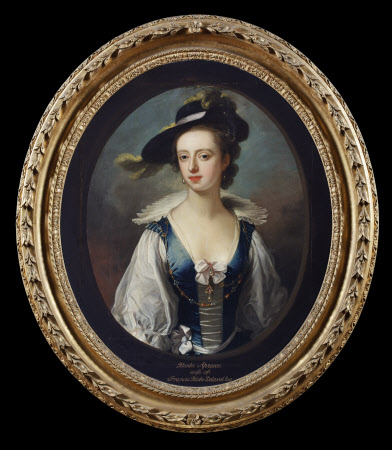Rhoda Apreece, Mrs Francis Blake Delaval (d.1759)
attributed to Enoch Seeman the younger (Gdańsk c.1694 – London 1744)
Category
Art / Oil paintings
Date
circa 1730
Materials
Oil on canvas (oval)
Measurements
889 x 737 mm (35 x 29 in)
Place of origin
England
Order this imageCollection
Seaton Delaval Hall, Northumberland
NT 1276716
Caption
Rhoda Apreece was the wife of Captain Francis Blake Delaval (1692 – 1752). Her costume appears to be seventeenth century, and was inspired by Rubens’s portrait of Helene Fourment (Gulbenkian Lisbon). She and Sir Francis had twelve children (eight sons and four daughters). It was difficult to accommodate them at Seaton Delaval, which was a house designed for a bachelor Admiral, so some of them were sent to stay with relatives in other Delaval houses at Dissington and Ford. The unruly brood became unknown as the ‘Gay Delavals’, renowned for their exuberant lifestyle and theatrical productions. Rhoda inherited Doddington Hall from her maternal grandfather, Sir Thomas Hussey, in 1749.
Summary
Oil painting on canvas (oval), Rhoda Apreece, Mrs Francis Blake Delaval (d. 1759), attributed to Enoch Seeman (Dantzig c.1694 - London 1744/5), 1730s; inscribed with old inscription, bottom left, painted out: ?Rhoda Apreece / wife of / [Francis?] Delaval Esqr and later, in yellow, bottom centre: Rhoda Apreece / wife of / Francis Blake Delaval Esq. Half-length, standing, facing, in a plunging blue corseted dress with white sleeves and collar, and a feathered hat
Full description
Daughter of Robert Apreece and Sarah Hussey, she married Captain Francis Blake Delaval (1692 – 1752) at St. Anne’s church, Westminster, in August 1724. The Husseys lived at Doddington, to which she was heir, a hall built by Thomas Tailor, Registrar to the Bishop of Lincoln in 1600 and designed by Robert Smythson. The Hall passed to the Hussey family by marriage, when the Tailor line died out. The Husseys were penalised by Cromwell for their Royalist support, and were considerably impoverished, such that the house was neglected until 1760, when Sir John Delaval restored it. Rhoda inherited the house from Sir Thomas Hussey of Doddington, her maternal grandfather, in 1749. She and Sir Francis did not move into Delaval Hall, which had not yet been completed by Sir George, until 1728. Accommodating their twelve children (eight sons and four daughters) into a house designed for a bachelor Admiral, was difficult, and some of them were sent to stay with relatives in other Delaval houses at Dissington and Ford. The unruly brood became unknown as the ‘Gay Delavals’, renowned for their exuberant lifestyle and theatrical productions. Her costume is an idiosyncratic version – combined with lacing – of that in Rubens’s portrait of Helene Fourment (Gulbenkian Museum, Lisbon; then in Sir Robert Walpole's collection), which inspired dozens of imitations in the mid-C18th, after it was first adopted by John Vanderbank around 1730. It is particularly common in the works of painters, such as Hudson, who employed Van Aken as a drapery painter – but in none of their paintings does the costume resemble this. Anthony Mould prefers an attribution to Hudson (he also noted that the right-hand side was flattened with some losses). Alastair Laing felt the hand was crisper than Hudson, and too stylised for Pond, before realizing that the treatment of the eyes, in particular, betray Seeman’s hand. (Amanda Bradley)
Provenance
accepted in lieu of tax by H.M.Treasury and transferred to the National Trust in 2009
Credit line
Seaton Delaval, The Hastings Collection (National Trust)
Marks and inscriptions
Bottom centre: Incription bottom centre: "Rhoda Apreece, wife of Francis blake Delaval esq"
Makers and roles
attributed to Enoch Seeman the younger (Gdańsk c.1694 – London 1744), artist Arthur Pond (London 1701 – Rome 1758), artist Thomas Hudson (Devonshire 1701 – Twickenham 1779), artist
